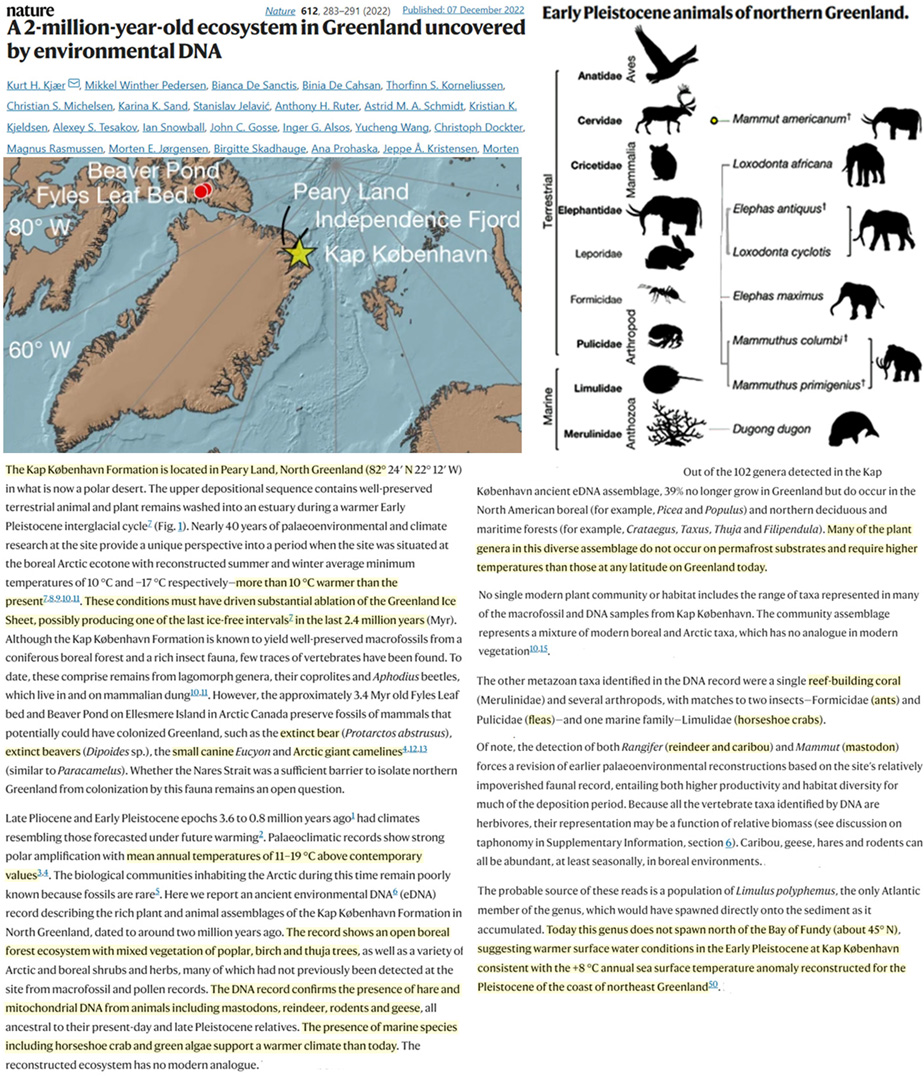An ancient vegetative and fauna ecosystem discovery in northernmost Greenland reveals how substantially warmer polar climates were when CO2 levels were said to be much lower than today.

Reconstruction of the Kap København Formation ecosystem 2 million years ago. Image credit: Beth Zaiken. Source: Sci.News
The northern coasts of Greenland are today a barren polar desert. Existing moisture is frozen into permanent ice sheets at these latitudes, precluding plant growth.
But two million years ago, when CO2 levels were claimed to only hover around 300 ppm, an 11-19°C warmer-than-today north Greenland (82°N) had no ice sheet coverage and instead was teeming with vegetation (shrubs, herbs), as well as birch, poplar, and thuja forests (Kjaer et al., 2022).
Megafaunal browsers such as mastadons (elephants) had access to abundant food sources (berries, twigs, leaves, etc.). Caribou and reindeer grazers, hare, and rodents thrived in the green landscape. Geese soared in the High Arctic skies.
Sea coasts near northern Greenland had green algae, coral reefs, and dugong – marine animals cousin to the manatee. Horseshoe crabs that today cannot spawn in waters any colder than 45°N (southern France) were able to occupy the much warmer-than-today Arctic waters at 82°N.
The annual sea surface temperatures (SSTs) at these Arctic latitudes have been estimated to be 8°C during this time, which is slightly warmer than the annual SSTs in New York’s Hudson Bay today (Galbraith and Larouche, 2011).
Interestingly, human beings were also living in China two million years ago (Zhu et al., 2018). For now, climate alarmists and activists have yet to blame these ancient humans for the much warmer temperatures facilitating these rich High Arctic ecosystems.






I miss the good old days when the earth wasn’t so damn cold.
Unfortunately, geologic history has no persuasive value to the alarmists. Science today is “Special”.
Climate is determined by a number of variables. We don’t know what caused the LIA or warm periods. It’s easy for alarmists cto say other, unknown factors that changed caused ancient climate changes but TODAY only CO2 has changed, so that’s it.
Bad thinking, but when you claim today is Special, any argument rules.
And the Quaternary ice age, a warm interglacial in which we now live, was supposed to have started 2.6 mya .
Shouldn’t there have been massive sea level rise?
Interesting. I would wonder, if a geologist has visited the area in question, after all, even america was south of the equator years ago. So I would wonder, how long has Greenland been there?
[…] From NoTricksZone […]
we a need a complete timeline picture, as much as possible. The Isthmus Panama closed 2.5MYA? Prior to then, the warm Atlantic equatorial water should have flowed through Gulf (bay/channel?) of Mexico, to the Pacific. Also, there was no ice cap in the north. When it closed, the warm water flowed back out the strait of Florida into the north Atlantic.
The warm water has high evaporation that ultimately contributed to persistent snow coverage of the northern high latitude land masses? and our current ice age. but in the meantime it was much warmer?